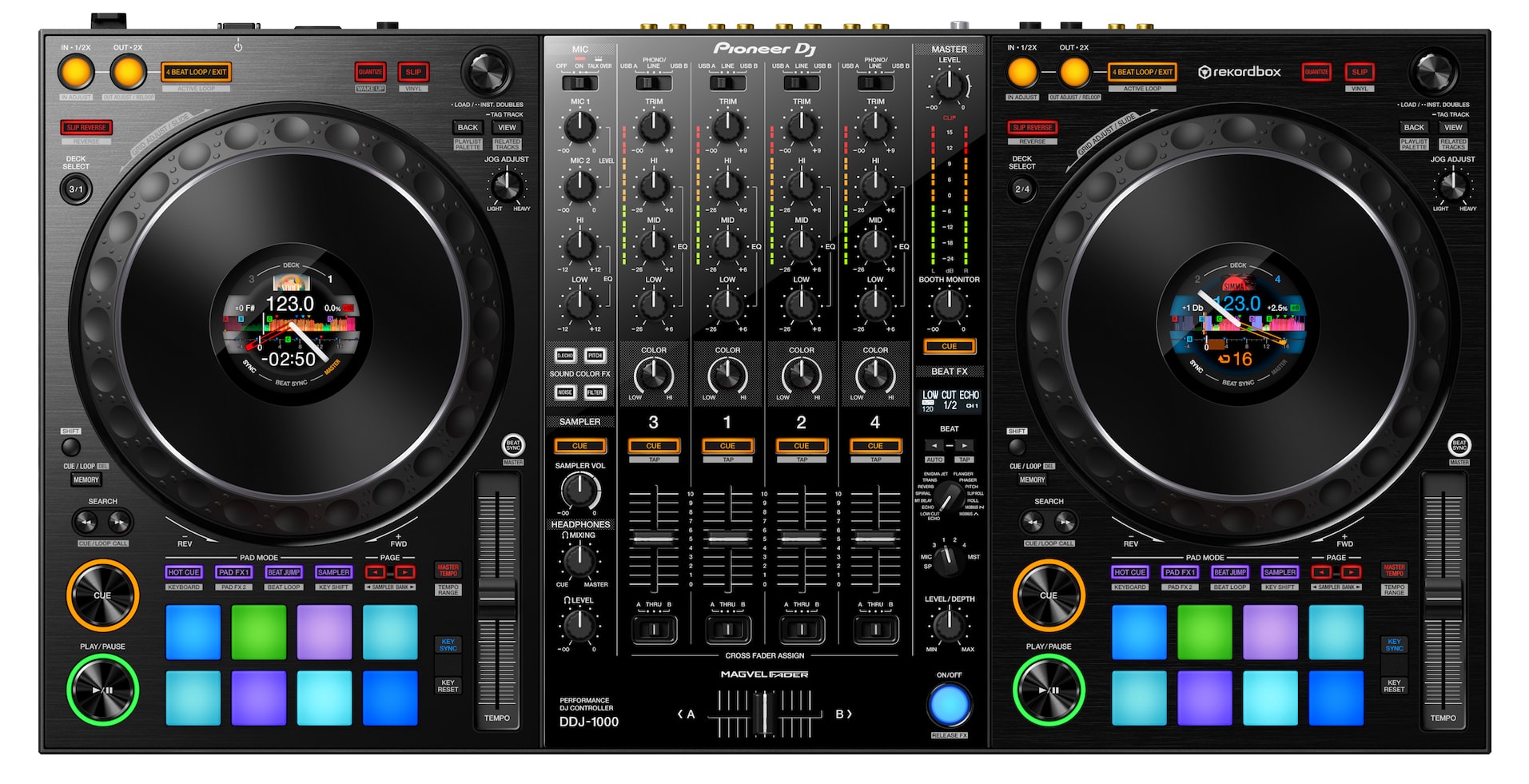Editorial review of the Pioneer DDJ-1000 Rekordbox Controller. Deep-dive into features, jog wheels, connectivity, performance pads, mixer, effects, pros, cons, and why it’s ideal for serious DJs.
Pioneer DDJ-1000 Rekordbox Controller Review: Club-Standard Features for Professional DJs
Pioneer’s DDJ-1000 Rekordbox Controller bridges the gap between club-standard gear and portable controllers, bringing an authentic CDJ + DJM mixer experience to your home or mobile setup. With full-size jog wheels taken from the Nexus 2 range, advanced performance features, dual USBs for seamless handovers, and deep Rekordbox integration, the DDJ-1000 delivers premium features at a competitive price point. Here’s an in-depth editorial look at what this flagship controller offers.
Hybrid Design: Nexus Club Feel Meets Controller Flexibility
The DDJ-1000 is built to feel like a pair of CDJs combined with a four-channel DJM-style mixer, wrapped into a powerful controller. It’s about an inch wider than previous controllers like the DDJ-RX or SX2 — allowing for full-size, pressure-sensitive jog wheels. These are not just cosmetic upgrades: they provide CDJ-level tactile response, jog adjust tension control, and offer vinyl and slip modes for scratch DJs and creative mixers alike.
Large Jog Wheels with Integrated Displays
At the center of each jog wheel is a backlit display, showing an overview waveform, BPM, elapsed/remaining time, phase meter (helpful for counting beats until next cue points or drops), deck number, and sync status. The playhead marker is clear and easy to follow, with cue and marker positions easily readable, making scratching and live cueing much more intuitive.
Professional Connectivity
Connectivity is a strong point. Dual USB ports let you connect two laptops simultaneously — ideal for back-to-back sets or smooth DJ changeovers. The DDJ-1000 also boasts four RCA inputs for CDJs/turntables, XLR and RCA master out, a booth output, and dual headphone outputs.
Performance Features: Bringing Club Creativity Home
The eight performance pads per deck unlock up to eight different modes. Hot cues (up to sixteen per deck using page functions) let you jump or finger-drum between tracks. Beat jump, pad FX, and sampler modes add creative flexibility for live remixing and transitions. The mixer section includes a dedicated sampler volume knob, meaning you don’t sacrifice a channel to trigger samples mid-set.
Keyboard and Key Shift Modes… The DDJ-1000 leverages Rekordbox’s powerful key-shifting and tone play functionalities. Keyboard mode lets you pitch the track from any cue point via the performance pads, covering an octave above and below the original key. Key shift lets you harmonically blend tracks, while key sync automatically matches keys for smooth, musical transitions.
Pad Customization
With Rekordbox’s pad edit mode, you can fully personalize the pad layouts to suit your mixing style or genre, assign favorite effects, or build custom performance banks for routines — a professional feature that sets it apart.
Mixer Section: True DJM Experience
The built-in mixer mirrors the DJM 900 Nexus 2, with four channels, Magvel crossfader for seamless cuts, 3-band EQ and trims, and sound color effects (Noise, Echo, Filter, Dub Echo). The mixer works as a stand-alone unit for external decks and sources, even when not connected to Rekordbox.
Beat FX Channel
The effects section is extensive, with classic Pioneer beat effects plus several exclusive to Rekordbox, such as Mobius Saw and Mobius Triangle — useful for building and releasing energy during sets. The beat FX are routed in a familiar channel-select layout, with tap and auto functions, ensuring you can time your effects precisely.
Workflow, Speed, and Intuitive Browsing
Track browsing is handled with rotary knobs and push-to-load buttons, emulating the club-standard workflow. The controller’s layout, ease of switching decks, memory cue and loop options, and tactile controls make it feel instantly familiar for club DJs, while providing a learning curve for those stepping up from entry-level gear.
Value and Market Position
At around £1,059 ($1,199), the DDJ-1000 offers immense value, essentially delivering CDJ club features and a DJM mixer in one controller — a setup that would cost multiples more if pieced together with standalone gear. It’s compact for mobile gigs, robust enough for clubs, and flexible for hybrid DJ setups.
Pros
- Full-size, pressure-sensitive jog wheels with center displays
- Four-channel DJM-style mixer, dual USB for easy changeovers
- Advanced performance pads and customizable pad edit mode
- Powerful Rekordbox integration: keyboard, key sync, beat jump
- Stand-alone mixer mode: works with external decks
- Magvel crossfader for scratch DJs
- Excellent effects section rivaling high-end mixers
Cons
- Bulkier than entry-level controllers (but still portable)
- Designed for Rekordbox: Serato/Traktor users may prefer alternatives
- Premium price point, though justified by features
Editorial Verdict: Who’s It For?
The Pioneer DDJ-1000 is the controller for serious DJs who want club-standard gear without the cost or size of CDJs and DJM mixers. It’s ideal for home studios, mobile performers, and professionals who need a gig-ready, versatile device. If you’re planning to transition to club booths, or want to practice at home with the same workflow, this controller is the closest you’ll get to Pioneer’s flagship experience at a fraction of the price.
Whether you’re spinning at parties, producing routines, or planning to hit the club circuit, the DDJ-1000 offers everything you need — precision, power, and flexibility. It’s a benchmark in controller design and the go-to pick for Rekordbox DJs.


